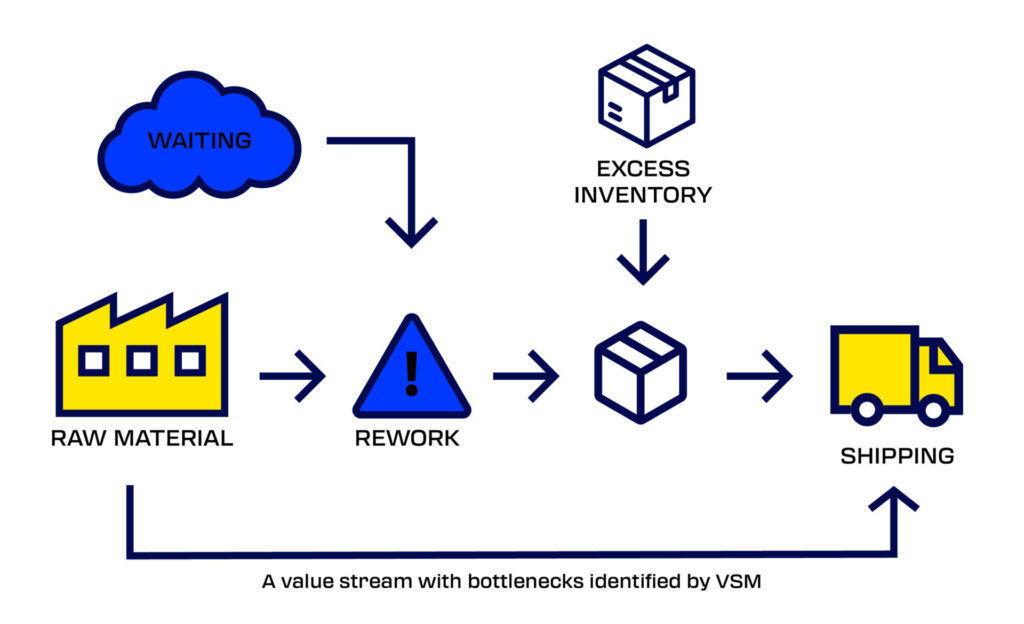Many companies invest in automation, digitalization and new processes, but they are not always able to identify at which stages there are delays, material waste or activities that do not add value to the customer.
It is in this context that VSM (Value Stream Mapping) stands out as a powerful tool for promoting real and sustainable improvements.
In this article, we will explore how VSM can be applied in practice in the industrial sector, the benefits it provides, the main challenges faced and how to overcome them.
If you are looking for more control, clarity and results on your factory floor, continue reading.
WHAT IS VSM?
Value Stream Mapping is a tool that helps companies see, in a visual and organized way, how value is created and delivered to the customer throughout a process.
This includes all stages of the process, from the arrival of the raw material to the final product ready for shipping, showing where there is waste, delays, rework and inefficiency.
Lincoln Gatti, Vockan Senior Consultant, explains that VSM “is a visual tool used in Lean Manufacturing to analyze and document the flow of materials and information from the purchase of raw materials to the delivery of the final product to the customer, with the aim of analyzing the current process map and, subsequently, creating a future map with the changes needed to eliminate this waste, optimizing the flow of materials and information”.
It allows us to understand how long each activity takes, which of them really add value and which only consume resources. This is done through a simple and objective design, which gathers real data from the operation and brings to light problems that are often hidden in day-to-day operations.
More than a map, VSM guides a practical approach: seeing all the stages of the process to eliminate waste and make production more efficient.

IMPORTANCE OF VSM FOR INDUSTRY
In an industrial environment, identifying where and how resources are being misused is one of the greatest challenges, especially in complex processes with multiple stages.
It is in this scenario that VSM gains strategic relevance, as it helps to highlight bottlenecks, rework, communication failures and other forms of waste that often go unnoticed in the operational routine.
The tool’s greatest advantage is its ability to make visible what is hidden in the day-to-day production, pointing out inefficiencies that would be difficult to notice through isolated reports or metrics alone. For industries, this vision is essential.
Another important benefit is the support that VSM offers for decision-making based on real data. This raises the level of operational management and reduces the risk of misdirected investments.
In addition, Value Stream Mapping plays a strategic role in building a culture of continuous improvement. As it involves different areas and people in the mapping and analysis process, it encourages team engagement and collaboration between sectors.
The result is a more participatory environment focused on solving real problems, with gains in productivity and quality. As such, it is an essential tool for the industry that wants to be more competitive, agile and prepared for the future.
A concrete example of the impact of VSM on the industry comes from GE Aerospace, which, in partnership with Avianca, applied value stream mapping to Celma’s engine maintenance workshop (MRO) in Brazil.
According to the QAD Redzone article, the initiative resulted in a 54% reduction in total service time (TAT), reducing the cycle from 85 to just 39 days. Through VSM and a Kaizen event, the team identified bottlenecks and rework cycles, streamlining the cost estimate approval process — which fell from 24 to 11 days — and improving coordination between Celma engineers and Avianca consultants.

Read also: How to Apply Agile Methodologies in Industry and Increase Operational Efficiency
PERFORMANCE INDICATORS IMPACTED BY VSM
By mapping the end-to-end value stream, the industry gains greater clarity about process bottlenecks and the main points that affect its performance. From this, it is possible to monitor key indicators that guide decision-making and support continuous improvement initiatives.
Among the indicators most impacted by the application of VSM, lead time plays a central role. Reducing the total time between the start of the process and the delivery of the final product is one of the main objectives of the mapping.
Another essential indicator is takt time, which represents the production rate required to meet customer demand. Monitoring the planned takt time versus the actual takt time allows you to identify operational deviations and adjust the workflow to maintain on-time delivery and avoid overloading teams. This alignment between production rate and demand is essential for process stability.
Furthermore, VSM directly impacts OEE (Overall Equipment Effectiveness), an indicator that measures the overall efficiency of equipment. By highlighting downtime, loss of speed and defects, VSM contributes to more accurate diagnoses and action plans aimed at improving the performance of industrial assets.

MAIN CHALLENGES OF VSM AND HOW TO OVERCOME THEM
Although VSM is an extremely valuable tool for improving processes and increasing industrial efficiency, its practical application is not always simple.
However, understanding the most common obstacles is essential for industries to extract maximum value from this practice. Check out the table we have prepared for your company, about the challenges and strategies for overcoming them.
| Challenge | Description | Solution |
| Lack of reliable data | When information on cycle time, intermediate stocks or production capacity is incomplete or out of date, the generated map loses value. | Invest in data collection directly at the location where the work takes place, with the involvement of the production team. |
| Resistance to change | Many teams view VSM as an audit or a form of control, not as an improvement tool, and this can generate resistance. | Involve operators from the beginning of the process, explaining the objectives of the VSM in a clear and participatory way. Showing that the intention is to improve the process creates an environment of trust and collaboration. |
| Difficulty in seeing the process as a whole | In many companies, departments operate in isolation. Each area knows its part of the process well, but few have a view of the entire flow. | Form multifunctional teams for mapping. The presence of representatives from the areas allows the VSM to reflect the reality from end to end, strengthening the culture of integrated improvement. |
| Lack of continuity after mapping | In some cases, VSM is done, problems are identified, but no concrete action is taken. The roadmap remains stagnant, and team motivation suffers. | Ensure that VSM is part of a continuous improvement cycle. After mapping the current state and defining the future state, it is essential to prioritize actions, delegate responsibilities and monitor results. |
| Expectation of immediate results | Some organizations expect VSM to bring about major changes in a short period of time. When this does not happen, the method is eventually abandoned. | Make it clear that VSM is a diagnostic and guidance tool, and that results will come with the disciplined execution of improvement plans. |
3 STEPS TO APPLY VSM IN THE COMPANY
Applying Value Stream Mapping in practice does not need to be a complex process, but it requires organization, involvement of the right people and a willingness to look deeply into the processes. Below, we highlight 3 fundamental steps to implement value stream mapping in the industrial environment:
Choose the process and define the scope
The first step is to choose which process will be mapped. Ideally, start with a specific production line or product that has a relevant impact on the business or presents frequent problems.
Clearly delimit the beginning and end of the flow that will be analyzed and assemble a multifunctional team with representatives from production, logistics, quality and engineering.
Map the current state based on real data
With the scope defined, collect real data to build the current state map, visualizing all the stages of the flow: value-adding activities, waiting times, movements, intermediate stocks, lead time, cycle time, among others.
Use standardized VSM symbols to represent the flow of materials and information. The important thing is to capture reality clearly. Mapping is not an audit, but rather a diagnosis.
Design the future state and outline an action plan
After understanding the current state, the next step is to design the desired future state, that is, a leaner flow, with less waste and more added value. Think about what can be eliminated, what can be simplified and where the team can save time or reduce stock.
Based on this, define concrete improvement actions, with responsible parties, deadlines and goals. It is not necessary to solve everything at once; prioritize the points with the greatest impact. From there, apply continuous improvement cycles, such as the PDCA cycle, to transform the map into practical results.

Read also: Predictive Maintenance: What It Is, Techniques Used and Benefits
VALUE STREAM MAPPING IN INDUSTRY 5.0
In the era of Industry 5.0, the focus is not only on automation and efficiency, but also on mass customization, human-machine collaboration and sustainability. In this context, VSM ceases to be an exclusively analog tool and begins to act as a pillar of the digital transformation of industrial operations.
The combination of artificial intelligence (AI), machine learning (ML) and the Internet of Things (IoT) dramatically expands the potential of VSM. It is now possible to collect and analyze data continuously, in real time, directly from equipment, production lines and integrated systems.
This allows companies to identify hidden patterns, anticipate failures with predictive maintenance and make decisions based on more accurate data, no longer just by direct observation or manual records.
According to Lincoln Gatti, modern VSM connects directly to the trends of supply chain 4.0, from augmented reality for interactive visualization of flows and the circular economy, with a focus on reducing waste, reusing resources and strengthening industrial sustainability.
Finally, in manufacturing 5.0, where technology works at the service of people and large-scale personalization, VSM becomes even more relevant by aligning efficiency with purpose.
Mapping the value stream now means considering not only time and cost, but also environmental impact, ergonomics, customer experience and integration with the company’s digital ecosystem.
REDZONE’S ROLE IN MAXIMIZING VSM EFFICIENCY
Applying VSM on paper is just the first step. The real challenge is transforming this map into quick decisions, constant improvements and coordinated actions on the factory floor.
This is where QAD Redzone stands out. The platform directly integrates VSM principles into day-to-day operations — connecting operators, supervisors and managers around real-time data on the value stream. Every bottleneck, delay or waste is identified immediately, with clear visibility shared by the entire team.
This means that your industry no longer relies on retroactive analyses and starts to act preventively and collaboratively, accelerating continuous improvement cycles.
More than just mapping, Redzone makes VSM happen in practice.
Talk to a Vockan specialist and find out how QAD Redzone can transform your value stream into a competitive advantage.










